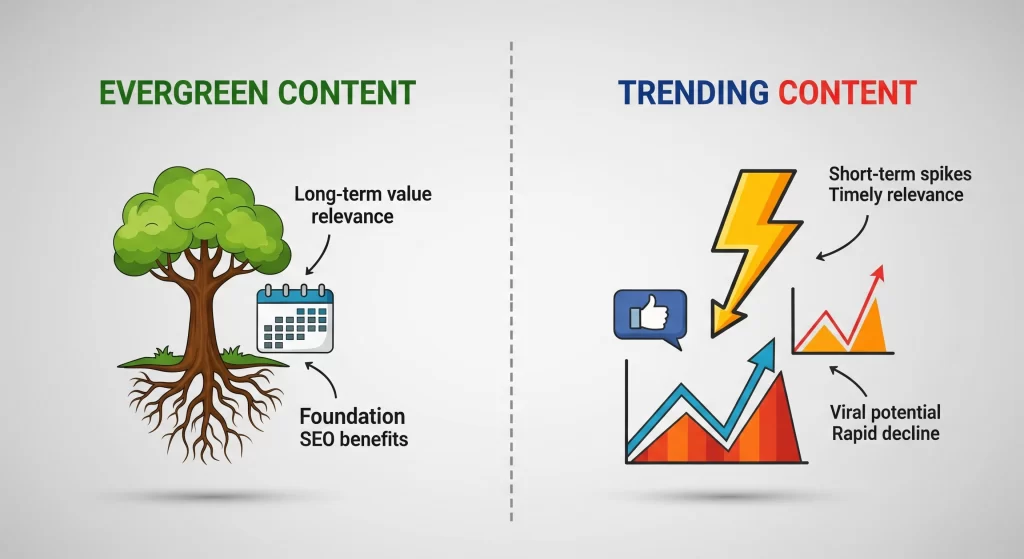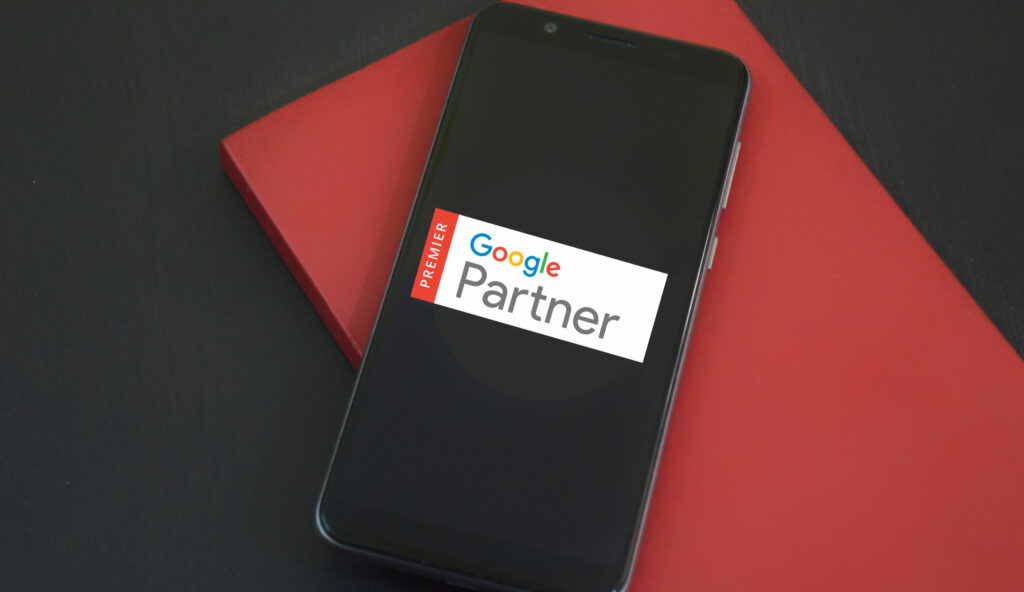Have you ever wondered, why for some topics you can take your sweet time and for others, the urgency can make you pull your hair out? Well, the two situations give us a glimpse of the two types of content – Evergreen (former) and trending (latter).
- Evergreen content is like a real evergreen tree. It stays green all year and is always useful.
- Trending content is like a dandelion, you blow on it once and the seeds spread fast, but soon it’s gone.
We’ll explain both in simple words, why one is great for long-term use and the other is good for short bursts of fun. We will also look at content longevity (how long content stays helpful) and how to build a smart SEO content strategy mixing them.
But first, let’s get to the basics.
What Is Evergreen Content?
Evergreen content is content that stays helpful, forever. You write it once, and people keep reading it for months or years.
These are always useful and don’t go out of date.
What Makes Evergreen Content Work?
- Timelessness: It doesn’t depend on news or seasonal trends, so it stays relevant
- SEO‑Friendly: Since people search for these topics all the time, your content shows up in searches again and again
- Consistency: It brings steady readers day after day, not just when something is hot.
- Easy to update: You can improve it bit by bit so it stays current, like fixing lessons with new facts.
What Is Trending Content?
Trending content is about what’s happening right now. It’s fresh, exciting, and lots of people talk about it… for a short time.
These are fun while they last, but after a while people stop talking about them
Why Trending Content Isn’t Evergreen
- It disappears fast after the trend is over, like birthday balloons that pop.
- Huge traffic for a little time, then it shrinks, like big waves in the sea that quickly fall
But when a trend hits, it can bring a lot of visitors and attention quickly
What Is the Difference Between Trending Content and Evergreen Content?
| Feature | Evergreen Content | Trending Content |
| Lifespan | Lasts for years | Lasts days or weeks only |
| SEO value | Builds long-term ranking | Short boost, then fades |
| Audience help | Solves ongoing, common questions | Captures attention in the moment |
| Maintenance | Low, with occasional refreshes | Needs frequent creation and updates |
| Traffic pattern | Slow, steady spikes over time | Big spike then drop fast |
Evergreen content is like a library book. It keeps giving value. Trending content is like a daily newspaper. It’s only useful today.
Why Is Evergreen Content Effective?
Evergreen content is powerful for businesses because:
- Long-term traffic: It keeps bringing people long after publishing.
- Strong SEO boost: Search engines like Google favor content that stays helpful over time.
- Trust builder: People come back to your site because they know you give good, reliable info.
- Great return on effort: One high-quality evergreen article can deliver value for years.
What Is the Difference Between Evergreen Content and Timely Content?
Evergreen content is timeless, always useful.
Timely content, which is often trending content, is tied to a date, event, or news. It quickly becomes outdated.
Timely content usually stops being helpful after the event passes, while evergreen stays fresh for a long while.
What Is the Value of Evergreen Content?
Now, let’s talk about what makes evergreen content valuable for your blog, business, or website:
- Content longevity means steady traffic
You get readers regularly even after a long time because your content stays helpful. - Improved SEO over time
Because evergreen content gains links and keeps ranking, your site becomes stronger in search engines. - Brand authority and trust
When you consistently offer evergreen content, people see you as smart and helpful. - Better return on investment (ROI)
One evergreen blog post can provide value for years, so it’s a wise way to spend your time and effort, and your money if someone is doing it for you. - Easier to share and reuse
You can turn evergreen content into video clips, infographics, or social media posts to reach more people.
How Evergreen and Trending Work Together in SEO Content Strategy
To make your SEO content strategy strong, it’s best to use both evergreen and trending content together.
The Balanced Mix
- Start with evergreen content to build a strong base. For example FAQs, tutorials, or how-to guides.
- Fill in with trending content occasionally to catch what’s hot—like current news or viral topics.
- A good rule is 70% evergreen, 30% trending, or even 80/20. This keeps your site steady but also lively.
How You Combine Them
- Write evergreen content, then sometimes update it with new info if something changes, like “SEO Tips: What’s Changed in 2025?”
- Turn trending content into evergreen later. For example, if there’s big news, you can follow up with a “How it works” guide that becomes evergreen.
- Share evergreen posts again after they’re published, like in newsletters or social media, to keep traffic flowing.
Planning Your Calendar
Think of your content calendar in tiers:
- Tier 1: Big evergreen pillar posts (like core guides, once a month)
- Tier 2: Seasonal or mid-length updates
- Tier 3: Quick trending posts as needed
This helps keep your content fresh and solid.
How this Synergy of Evergreen Content & Trending Content Bring Results
Evergreen content builds your site’s strong foundation, like books in a library that keep being useful. Trending content brings fast excitement and lots of eyeballs right now. Using both together in an SEO content strategy is like balancing cake and veggies, tasteful and healthy.
The ideal mix is roughly 70–80 % evergreen content and 20–30 % trending content for long-term growth with occasional bursts of attention
Tips: How to Create Good Evergreen Content
Here’s how to make evergreen content work best:
- Choose evergreen topics like questions people always ask, like “what is SEO content strategy”.
- Optimize for SEO by using evergreen keywords, writing clear headings, and including long-tail search phrases.
- Structure content well with bullets, subheads, simple examples, so anyone (even noobs) can read it easily.
- Update occasionally. Refresh stats, fix broken links, and polish examples to maintain relevance.
- Repurpose content into videos, infographics, newsletters, or social media snippets to reach more people over time.
What Happens with Trending Content?
Trending content is great for:
- Grabbing attention fast. This is ideal for announcements, viral topics, or seasonal moments.
- Quickly boosting social shares, engagement, and brand visibility while the topic is hot.
- Pushing your site to Google Discover or trending search features when the news is fresh.
But remember:
- Its value fades fast, like fireworks, it lights up the sky briefly then disappears.
- You have to quickly and in a sort of regular way catch up with what’s new & worth the hype.
Balancing Evergreen with Trending Content
Here’s how to use both content types together smartly:
- Start with evergreen pillar posts, deep guides on big topics. Use trending posts to capture attention, then link back to your evergreen pieces for deeper value.
- Convert trending topics into evergreen content, like turning a news story into a “what this means and how to do it” guide.
- Internal link trending posts to evergreen content to keep visitors on your site and build topic clusters.
Final Tips: Easy Ways to Write Well
- Use simple words and short sentences, like telling a story to a friend.
- Keep paragraphs small and use bullet points to make ideas easy to see.
- Don’t mention specific years (like “2025”), use phrases like “recently” or “as of now”.
- Add questions in headers like “How do I do this?”. This makes reading fun and searchable.
- Mix in keywords naturally like evergreen content, trending content, content longevity, and SEO content strategy so search engines see what your post is about.
Conclusion: What Works Best?
There’s no winner in “Evergreen vs. Trending Content.” The real champion is a content plan that uses both:
- Evergreen content gives you strong foundations, long-term traffic, and SEO stability.
- Trending content adds energy, visibility, and relevance in the moment.
With the right balance, you build content longevity and keep things fresh and exciting for your readers. Over time, your SEO content strategy will help readers find you and stick around. If you’re looking for SEO services, we, at Wildnet Technologies, are happy to help you out. Get in touch today.
FAQs
What is the key difference between evergreen content and trending content?
Answer:
- Evergreen content is timeless, it stays helpful for months or even years (content longevity), like “how‑to” guides or FAQs.
- Trending content, on the other hand, is about what’s hot right now, live events, viral news, or seasonal topics that fade quickly.
Which type of content delivers better long‑term traffic and SEO benefits?
Answer:
Evergreen content usually wins for long‑term results. Because searchers continually look for these topics, the content keeps pulling traffic and builds domain authority over time, boosting your SEO content strategy.
When should I use trending content versus evergreen content in my SEO content strategy?
Answer:
Use evergreen content to establish steady, long‑lasting value (the backbone of your SEO). Use trending content to spark immediate attention, like responding to news or seasonal events. Together, they form a sustainable SEO content strategy.
Does evergreen content need to be updated, and how often?
Answer:
Yes, occasional updates help evergreen content stay accurate and helpful, such as refreshing stats or improving examples, typically every 6–12 months.
Can trending content someday become evergreen? How do I repurpose it?
Answer:
Yes, it can, but there are some conditions. If a trending topic has lasting relevance, you can convert it into evergreen content, e.g., expand a news highlight into a deep “how it works” guide. Then keep updating it so it retains value over time.
What’s the ideal mix of evergreen and trending content in my calendar?
Answer:
Well, the recommended proportion is 70 to 80% evergreen and 20–30% trending content. As it is seen to give content longevity while allowing timely visibility and boosts in traffic. But, we suggest you do an internal analysis & brand position to get a better number.
Which type of content attracts backlinks and improves domain authority?
Answer:
For that, evergreen content is the one. If you wonder why, it’s because it’s useful over time, and other websites link to it naurally. This eventually helps in an improved site’s authority..
What metrics should I track to assess performance of evergreen vs. trending content?
Answer:
- For evergreen: track steady organic traffic growth, search ranking, backlinks, and conversions.
- For trending content: monitor short‑term traffic spikes, social shares, and referral traffic. These help measure quick engagement versus long‑term value.
How does evergreen content compare to timely content?
Answer:
Evergreen content is timeless and stays helpful long-term. Timely content (a subset of trending content) is tied to specific events or dates, and loses relevance once those pass. Evergreen equals long shelf life; timely equals useful in the moment.
How resilient is evergreen content in the face of algorithm changes?
Answer:
Evergreen content is inherently robust. Since it consistently addresses user queries and gets updated occasionally, it’s better equipped to withstand algorithm updates compared to fleeting trending posts.







